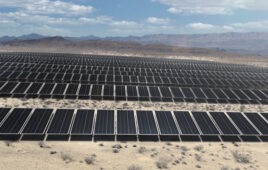Talk about a solarcoaster. After having its tariff exemption revoked in October, bifacial modules are again exempt from the current 25% Section 201 tariff. The U.S. Court of International Trade (CIT) issued a temporary restraining order on the bifacial module exemption revocation in November, and now it has decided to block the U.S. Trade Representative’s (USTR) decision to revoke the exemption. CIT will allow the exclusion of bifacial modules from the Section 201 tariffs to remain in place for the foreseeable future.
“This is an important temporary reprieve for the bifacial module exclusion,” said SEIA president and CEO Abigail Ross Hopper. “We will continue to make the case that the Section 201 tariffs are harming the U.S. industry and the American consumer and that the bifacial exclusion was a fair and reasonable solution to the problem of domestic module supply shortages. In the utility segment, for example, there is approximately only 1 GW of domestic crystalline silicon photovoltaic capacity to service nearly 10 GW of 2020 demand. Continued harsh tariffs will cut billions of dollars in private investment and put a hold on 62,000 American jobs.”
The initial restraining order was granted after SEIA intervened in a case to the CIT on behalf of Chicago-based developer Invenergy Renewables. The developer said it entered into contracts with module pricing based on having the bifacial exemption, and that the USTR’s exemption revocation violated the Administrative Procedure Act.
It’s been reported that Hanwha Q CELLS and First Solar were among the module manufacturers pressuring the USTR to remove imported bifacial modules’ free pass into the utility market. Wood Mackenzie Power & Renewables predicted a tenfold increase in global bifacial installations between 2019 and 2024, with a significant jolt from the U.S. market. WoodMac estimated 2 GW of bifacial installations in 2020 in the United States, fueled by the original tariff exemption bringing “much-needed relief to the module supply chain.” Q CELLS and First Solar want the utility market to prefer their monofacial modules.
But now any brand of imported bifacial modules will again be exempt from the tariffs. Many popular brands have bifacial lines, including Trina Solar, Vikram Solar, LG, LONGi and JinkoSolar.
The original Section 201 tariff on imported solar panels currently stands at 25% and will drop to 20% in 2020. Along with bifacial modules, certain panels using interdigitated back contact (IBC) technology are also exempt from the tariffs.
The Section 201 tariffs are up for a midterm review this coming February, and a hearing is being held today. SEIA is in attendance, as is Solar Power World. Be sure to follow us on Twitter for the latest developments from that hearing.
We’ve been covering the affects of the solar panel tariffs since the beginning. Check out our recent news reports here, including the latest on tariffs on Chinese inverters, batteries and mounting system components.






What is the current status of the anti-dumping tariffs on bifacial panels? Is it still revoked or have they been reinstated?
Currently no tariffs: https://www.solarpowerworldonline.com/2020/04/tariff-exemption-for-bifacial-solar-modules-officially-revoked-for-good/